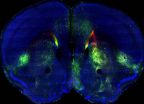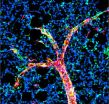(Press-News.org) HONOLULU – Instruments strapped onto and ingested by sharks are revealing novel insights into how one of the most feared and least understood ocean predators swims, eats and lives.
For the first time, researchers at the University of Hawaii and the University of Tokyo outfitted sharks with sophisticated sensors and video recorders to measure and see where they are going, how they are getting there, and what they are doing once they reach their destinations. (Go to http://www.youtube.com/watch?v=UHDOAmXRw-0&feature=youtu.be for video).
Scientists are also piloting a project using instruments ingested by sharks and other top ocean predators, like tuna, to gain new awareness into these animals' feeding habits. The instruments, which use electrical measurements to track ingestion and digestion of prey, can help researchers understand where, when and how much sharks and other predators are eating, and what they are feasting on.
The instruments are providing scientists with a "shark's eye" view of the ocean and greater understanding than ever before of the lives of these fish in their natural environment.
"What we are doing is really trying to fill out the detail of what their role is in the ocean," said Carl Meyer, an assistant researcher at the Hawaii Institute of Marine Biology at the University of Hawaii at Manoa. "It is all about getting a much deeper understanding of sharks' ecological role in the ocean, which is important to the health of the ocean and, by extension, to our own well-being."
Using the sensors and video recorders, the researchers captured unprecedented images of sharks of different species swimming in schools, interacting with other fish and moving in repetitive loops across the sea bed. They also found that sharks used powered swimming more often than a gliding motion to move through the ocean, contrary to what scientists had previously thought, and that deep-sea sharks swim in slow motion compared to shallow water species.
"These instrument packages are like flight data recorders for sharks," Meyer said. "They allow us to quantify a variety of different things that we haven't been able to quantify before."
"It has really drawn back the veil on what these animals do and answered some longstanding questions," he added.
Meyer and Kim Holland, a researcher also at the Hawaii Institute of Marine Biology, are presenting the new research today at the 2014 Ocean Sciences Meeting co-sponsored by the Association for the Sciences of Limnology and Oceanography, The Oceanography Society and the American Geophysical Union.
Sharks are at the top of the ocean food chain, Meyer noted, making them an important part of the marine ecosystem, and knowing more about these fish helps scientists better understand the flow of energy through the ocean. Until now, sharks have mainly been observed in captivity, and have been tracked only to see where they traveled.
These new observations could help shape conservation and resource management efforts, and inform public safety measures, Holland said. The instruments being used by scientists to study feeding habits could also have commercial uses, including for aquaculture, he added.
INFORMATION:
AGU: A 'shark's eye' view: Witnessing the life of a top predator
2014-02-27
ELSE PRESS RELEASES FROM THIS DATE:
Mouse brain atlas maps neural networks to reveal how brain regions interact
2014-02-27
Different brain regions must communicate with each other to control complex thoughts and behaviors, but relatively little is known about how these areas organize into broad neuronal networks. In a study published by Cell Press February 27th in the journal Cell, researchers developed a mouse whole-brain atlas that reveals hundreds of neuronal pathways in a brain structure called the cerebral cortex. The online, open access, interactive image database, called the Mouse Connectome Project, provides an invaluable resource for researchers interested in studying the anatomy and ...
Study uncovers why autism is more common in males
2014-02-27
Males are at greater risk for neurodevelopmental disorders, such as autism spectrum disorder (ASD), than females, but the underlying reasons have been unclear. A large cohort study published by Cell Press on February 27th in the American Journal of Human Genetics provides compelling evidence in support of the "female protective model," which proposes that females require more extreme genetic mutations than do males to push them over the diagnostic threshold for neurodevelopmental disorders.
"This is the first study that convincingly demonstrates a difference at the molecular ...
Male goat essence really turns the females on
2014-02-27
Anyone who has ever spent time around goats knows they have a certain smell. By carefully analyzing eau de male goat, researchers reporting in the Cell Press journal Current Biology on February 27 have now identified a novel, citrus-scented ingredient that speaks directly to the females. It acts on female goats' brains to turn their reproductive systems on.
The study is the first to uncover a pheromone that activates the central reproductive axis, according to the researchers. Although the work was done in goats, the researchers say there is reason to think the findings ...
Supplement added to a standard diet improves health and prolongs life in mice
2014-02-27
Activating a protein called sirtuin 1 extends lifespan, delays the onset of age-related metabolic diseases, and improves general health in mice. The findings, which appear online February 27 in the Cell Press journal Cell Reports, point to a potentially promising strategy for improving health and longevity.
Sirtuin 1, or SIRT1, is known to play an important role in maintaining metabolic balance in multiple tissues, and studies in various organisms have shown that activating the protein can lead to many health benefits. Also, drugs that increase SIRT1 activity have been ...
By zooming in on arteries, researcher gets to the root of pulmonary hypertension
2014-02-27
You might think building muscle is a good thing, but that's often not so in the case of blood vessels in adults. In fact, excess smooth muscle is a root problem in many vascular diseases, as it causes arteries to constrict and blood pressure to rise. Now, an in-depth analysis of arterioles in mice with pulmonary hypertension explains how those misplaced smooth muscle cells develop.
The findings reported in the Cell Press journal Cell Reports on February 27th are important because nearly half of patients with pulmonary hypertension die within three years of diagnosis, ...
Yale study provides a breath of hope for pulmonary hypertension patients
2014-02-27
Most of us draw roughly 25,000 breaths a day without any thought. But for patients with pulmonary hypertension, a life-threatening increase in blood pressure in the lungs, even the smallest task can leave them gasping for air. A new study by researchers at Yale School of Medicine offers insight into the function of cells linked to this incurable and often fatal illness.
Published Feb. 27 in Cell Reports, the study is the first to explore the cellular mechanisms behind the changes in the way cells are organized in pulmonary arteries in pulmonary hypertension, which leaves ...
Internal logic: 8 distinct subnetworks in mouse cerebral cortex
2014-02-27
The mammalian cerebral cortex, long thought to be a dense single interrelated tangle of neural networks, actually has a "logical" underlying organizational principle, reveals a study appearing Feb. 27 in the journal Cell.
Researchers have identified eight distinct neural subnetworks that together form the connectivity infrastructure of the mammalian cortex, the part of the brain involved in higher-order functions such as cognition, emotion and consciousness.
"This study is the first comprehensive mapping of the most developed region of the mammalian brain: the cerebral ...
New discovery paves the way for medicine for people with hearing disabilities
2014-02-27
Researchers at Karolinska Institutet in Sweden have identified a biological circadian clock in the hearing organ, the cochlea. This circadian clock controls how well hearing damage may heal and opens up a new way of treating people with hearing disabilities.
Important body functions, such as sleep, the immune system, and hormone levels are controlled by a biological circadian clock. A team of researchers at Karolinska Institutet have now discovered that there is also a biological clock in the ear, controlled by genes known to regulate circadian rhythms. One of these ...
Disease-causing bacterial invaders aided by failure of immune system switch
2014-02-27
Immune system defenses against dangerous bacteria in the gut can be breached by turning off a single molecular switch that governs production of the protective mucus lining our intestinal walls, according to a study led by researchers at Yale, the University of British Columbia, and the Weizmann Institute of Science.
"This gut microbiota has been linked to the inflammation that triggers obesity, diabetes, metabolic disease, and most of chronic health problems of the Western World," said Yale's Richard Flavell, Sterling Professor of Immunobiology, Howard Hughes Medical ...
Fruit fly's pruning protein could be key to treating brain injury
2014-02-27
DURHAM, NC -- A protein that controls the metamorphosis of the common fruit fly could someday play a role in reversing brain injuries, said Duke University researchers.
This protein directs both the early development and regrowth of the tiny branches that relay information from neuron to neuron. Known as dendrites, these thin structures that resemble tree branches are responsible for receiving electrical impulses that flash throughout the body.
Incorrect dendrite development or injury has been linked to neurodevelopmental or psychiatric diseases in humans, such as autism, ...





